
Enjoying Spring in close-up.
by Dave Walker, UK
|
The plants and flowers we often take for
granted take on a whole new perspective if their colours,
textures and shapes are enjoyed at a larger scale. Just
getting closer to inspect by eye can reveal some detail,
but more can be seen by using a 10X hand lens or studying
subjects under the microscope.
A few common garden
and wild Spring flowers in the UK are examined here a
little more closely.
|
Daffodils
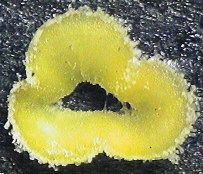 The cultivated
varieties of daffodil are one of the most common garden flowers
in Spring. There is a wild species in the UK (Narcissus
pseudonarcissus) but it's not common and shouldn't be
picked. The 'wild' daffodils in my area (shown above) are in fact
garden escapes. The garden daffodil is worth inspecting more
closely and the large flowers make it easy to handle for study.
The cultivated
varieties of daffodil are one of the most common garden flowers
in Spring. There is a wild species in the UK (Narcissus
pseudonarcissus) but it's not common and shouldn't be
picked. The 'wild' daffodils in my area (shown above) are in fact
garden escapes. The garden daffodil is worth inspecting more
closely and the large flowers make it easy to handle for study.
The end of the central female stigma is three-lobed and is easily
seen with a hand lens (the tip is shown right).
Tiny specks of pollen may have been transferred from the ripe
male stamens surrounding the stigma. Studying temporary mounts of
pollen is very easy; just tap a flower with ripe stamens over a
slide to dislodge some pollen and cover with a cover slip.
Daffodil pollen under dark field illumination using a home made
patch stop is shown below.
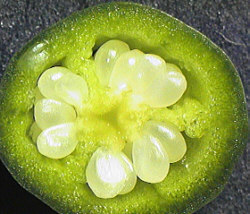
Cutting the green bulbous area immediately behind the flower
reveals the ovary with unripe seeds and is quite attractive under
a 10X hand lens (shown left).
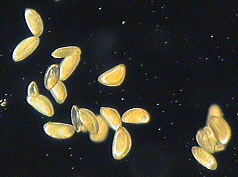
Daffodil pollen. 9X objective.
|
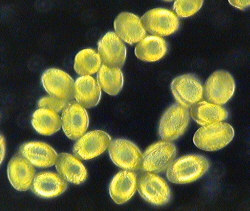
Lesser celandine pollen. 20X
objective. |
Lesser celandine
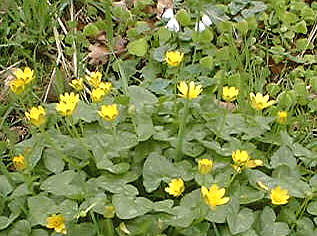 Lesser celandine
(Ranunculus ficaria) is a common wild flower in the UK
(shown right) and is a member of the Buttercup Family. This has a
very vivid yellow pollen and is shown above with darkfield
illumination. It's worth comparing the shapes and surface
features of flower pollen using temporary mounts, or build up a
slide collection of permanent pollen mounts. Common
names for wild flowers can be confusing (although the author has
never got to grips with their Latin names), as the Greater
Celandine (Chelidonium majus) in the UK is a totally
unrelated plant in the Poppy Family!
Lesser celandine
(Ranunculus ficaria) is a common wild flower in the UK
(shown right) and is a member of the Buttercup Family. This has a
very vivid yellow pollen and is shown above with darkfield
illumination. It's worth comparing the shapes and surface
features of flower pollen using temporary mounts, or build up a
slide collection of permanent pollen mounts. Common
names for wild flowers can be confusing (although the author has
never got to grips with their Latin names), as the Greater
Celandine (Chelidonium majus) in the UK is a totally
unrelated plant in the Poppy Family!
Coltsfoot
Coltsfoot (Tussilago farfara) is an attractive yellow
wildflower of early Spring and is a member of the Compositae
('Daisy') Family as the 'flower' head is made up of many tiny
flowers called florets. I've passed this flower many times, but
it's only when I looked at one with a 10X hand lens that I
noticed it had tiny glandular hairs on the stem and the sepals
behind the flowerhead. Incident lighting with a 3.5X objective on
the compound microscope shows them in more detail. It's worth
stopping to examine the hairs of leafs and stems, they can reveal
hidden secrets such as hooks, glands, forked ends etc.
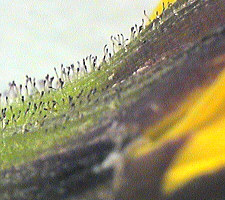
A 10X hand lens shows the hairs on a
coltsfoot stem above, but the microscope (3.5X objective)
reveals them more clearly (right). |
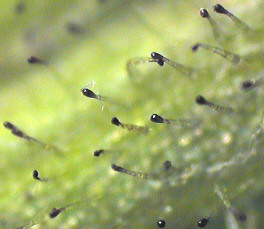 |
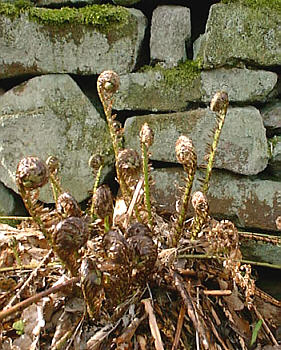 Non-flowering
plants
Non-flowering
plants
Although wild flowers tend to attract the eye, there are many
delightful plants worth studying that don't flower, notably the mosses, liverworts, ferns and horsetails. The new fern
fronds for example as they uncurl in Spring look rather curious
(shown right) and the scales
are well worth studying. Not to mention the fungi, moulds, algae and mosses
growing on the dry stone wall behind! Some of the fascinations of
these plants have been covered in previous Micscape articles.
(Some are linked above or visit the Library and type in
appropriate keywords using the Search engine).
So next time you are on a local country walk or even just in
the garden, take a closer look at the flowers and plants you may
have taken for granted, they may reveal some surprising hidden
secrets!
Comments to the author Dave
Walker welcomed.
Picture details.
Outdoor images: Fuji DX-10 digital camera.
Indoor macro: Panasonic CL-350 video camera
(420 line resolution) with Nikon 50mm SLR lens + SLR camera
extension tubes attached via adaptor.
Microscopy: Panasonic video camera on
Russian Biolam microscope using Russian achromatic objectives
with no eyepiece.
Editor's note: If you would
like to share some pictures of the fauna and flora of your area
whether just in close-up or on the macro or microscopic scale,
please contact us (link to Editor below).
Visit Gary
Baird's and Dave Walker's nature walks, where the countryside in close-up in
their areas (Carthage, Missouri, USA and the Southern Pennines,
West Yorkshire, England respectively) are explored.
© Microscopy UK or their
contributors.
Published in the April 1999
edition of Micscape Magazine.
Please report any Web problems
or offer general comments to the Micscape Editor,
via the contact on current Micscape Index.
Micscape is the on-line monthly
magazine of the Microscopy UK web
site at Microscopy-UK
WIDTH=1
© Onview.net Ltd, Microscopy-UK, and all contributors 1995 onwards. All rights
reserved. Main site is at www.microscopy-uk.org.uk with full mirror at www.microscopy-uk.net.

 The cultivated
varieties of daffodil are one of the most common garden flowers
in Spring. There is a wild species in the UK (Narcissus
pseudonarcissus) but it's not common and shouldn't be
picked. The 'wild' daffodils in my area (shown above) are in fact
garden escapes. The garden daffodil is worth inspecting more
closely and the large flowers make it easy to handle for study.
The cultivated
varieties of daffodil are one of the most common garden flowers
in Spring. There is a wild species in the UK (Narcissus
pseudonarcissus) but it's not common and shouldn't be
picked. The 'wild' daffodils in my area (shown above) are in fact
garden escapes. The garden daffodil is worth inspecting more
closely and the large flowers make it easy to handle for study.


 Lesser celandine
(Ranunculus ficaria) is a common wild flower in the UK
(shown right) and is a member of the Buttercup Family. This has a
very vivid yellow pollen and is shown above with darkfield
illumination. It's worth comparing the shapes and surface
features of flower pollen using temporary mounts, or build up a
slide collection of permanent pollen mounts. Common
names for wild flowers can be confusing (although the author has
never got to grips with their Latin names), as the Greater
Celandine (Chelidonium majus) in the UK is a totally
unrelated plant in the Poppy Family!
Lesser celandine
(Ranunculus ficaria) is a common wild flower in the UK
(shown right) and is a member of the Buttercup Family. This has a
very vivid yellow pollen and is shown above with darkfield
illumination. It's worth comparing the shapes and surface
features of flower pollen using temporary mounts, or build up a
slide collection of permanent pollen mounts. Common
names for wild flowers can be confusing (although the author has
never got to grips with their Latin names), as the Greater
Celandine (Chelidonium majus) in the UK is a totally
unrelated plant in the Poppy Family!

 Non-flowering
plants
Non-flowering
plants